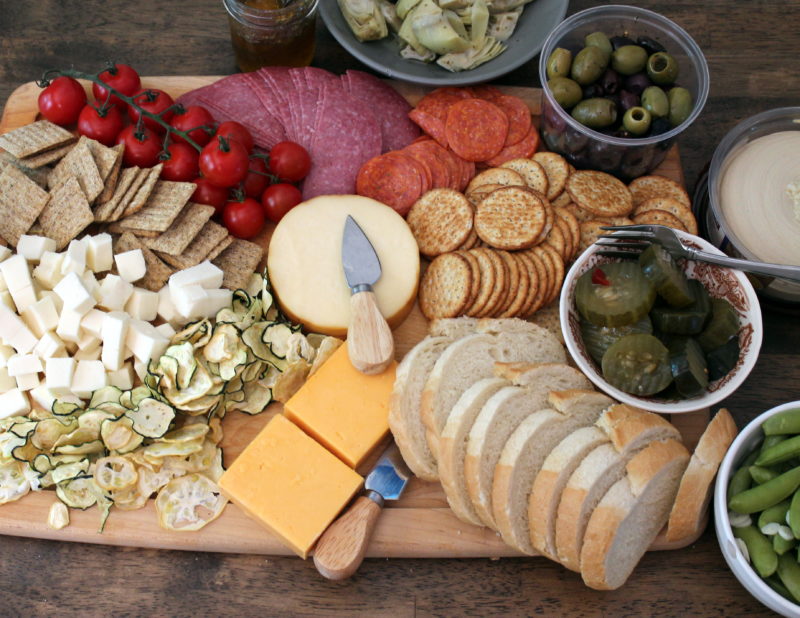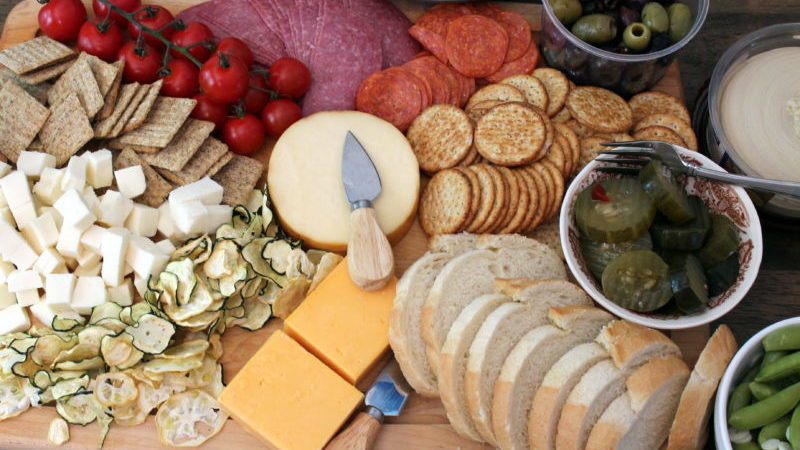
Antipasto is one of my favorite things to serve just about any time of year, but especially during the harvest season. Its at this time of year when the array of fresh vegetables is so abundant that it makes for an wildly colorful tray. This summer antipasto is a snapshot of a typical tray that I would serve.
How to Build an Antipasto Platter
I like to follow a few basic rules when creating my antipasto platters. This makes it super easy to recreate any time of year, with whatever I have on hand. Use these rules as a guideline as you sift through cabinets and farmers markets looking for seasonal ingredients.
1. Start with 2 Cured Meats
I love to start with prosciutto, which has a mild salty flavor. For the second meat, I like to go with salami, or chorizo, which both have a more robust flavor. I’ve also been known to use serrano ham, pepperoni, thin-sliced smoked duck breast, or venison summer sausage.
2. Add Cheese
Rule of thumb here is to select 2 cheese, one hard cheese, and one soft cheese. Some people like to go with more cheese, but I prefer to keep the veggies as the star of the show and opt for fewer meats and cheeses. Personally, I like to go with a local goat cheese and an aged cheddar, but a creamy mozzarella and Parmesan are more traditional. Really the sky is the limit here, go with whatever floats your boat.
3. Bring the Crunch
I always, always, always, have crackers. They are a required vehicle to get at least one component on the tray to your mouth. But, don’t think you need to stop there. I also like to add some spiced nuts or toasted chickpeas. This time of year it’s also a great idea to make a veggie chip in the oven or dehydrator for a bit of added crunch.
4. Something Sweet
In the wintertime I almost always opt for sun-dried tomatoes, or a fruit spread (see melba sauce or my favorite blueberry thyme jam), but come summertime, fresh fruit is just too easy. Sometimes I’ll kick it up a notch and use freshly made preserves since I’m usually processing them at the time anyway.
5. Add Salt
I tend to lean on pickles and olives for this piece of the puzzle. I feel strongly that olives are a must for a good tray but usually add another salty option as well. Anchovies are a fabulous option, especially in the winter months, but with summer in session, I like to throw together a quick pickle. Pretty much any vegetable can handle a quick pickle, with vinegar, salt and whatever herbs and spices hit my fancy. My favorites are carrot, cauliflower, cucumber (obviously), snap peas, roasted red peppers, and onions.
6. Bread is Required
Do I really need to say it? A good fresh crusty loaf of bread is just about the best thing ever, so of course, it’s absolutely needed for a good antipasto. Feel free to play with the type of bread, whether it be a french baguette, or focaccia, just be sure there is something on hand.
You can make a summer antipasto as easy or as difficult as you want. I’ve made entire trays with pre-purchased products in a pinch but also spent hours making everything from scratch. The later was definitely more satisfying if we are being honest. Its also a great way to clear out your pantry before you start restocking all the goods from this seasons bounty, just saying.
Mom tip: Typically an antipasto is served as an appetizer before a meal in Italy, but around here we have been known to have it as the meal. I mean it’s so easy to load up different items in a way that makes a really filling platter. Plus, it’s the easiest way to get my family to eat more veggies.

